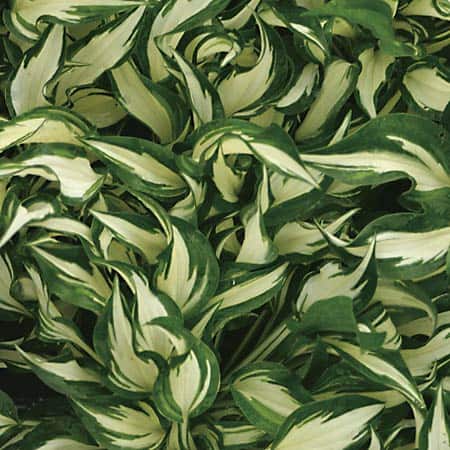
If you’ve had a look through the new spring 2013 issue of Garden Making, you might have noticed an article (written by myself!) about using large stones and boulders in garden beds. The limits of my imagination suggested weeping shrubs and small trees as good companions for boulders. However, I’ve now come across a collection of dwarf hostas (gardenimport.com), hardy to Zone 3, and a few of these would also be wonderful snuggled up to big rocks. Sometimes an enormous garden object is enhanced by partnership with a demure and intriguing plant.
I’ll admit to liking large hostas, and have many clumps of ‘Sum and Substance’, ‘Blue Umbrellas’, ‘Big Daddy’ and ‘Krossa Regal’. These big hostas are often 40 inches (1 m) tall and wide (with five-foot / 1.5-m flower scapes), enough to define an area, and make their own style relationships with anything in the landscape. Smaller hostas need to be used more thoughtfully. Lacking the brute size of their big cousins, little plants need careful placement to be sure they’ll be visible, and their ornamental assets prominent.
What could be more charming than a thick skirt of blue-green ‘Blue Mouse Ears’ hosta with eight-inch (20-cm) long leaves peeking out along the bottom of a dark charcoal armor rock? Or a sweet ruffle of 3.5-inch (9-cm) long, bright yellow ‘Appletini’ leaves ringing a granite boulder? These plants have consistent foliage through the growing season, and light purple flower spikes for several weeks.
Of course, dwarf hostas are handy for small spots wherever more detail is needed. Their compact form is ideal for neatening the odd corner spaces around steps, and filling in between clumps of tall plants like bearded iris, penstemon and perennial lobelia. A fancy dwarf hosta like variegated ‘Hideout’, with five-inch (13-cm) wavy leaves with dark green edges, wide cream interiors and dark purple flowers ensures garden areas will remain attractive after perennials finish flowering.
Hostas are strong plants that adapt to most garden soils, and pay for themselves quickly. Give them regular irrigation and an annual meal of compost or fertilizer, and they’ll soon be large enough for dividing. Just consider the long ribbon borders that could eventually come from an initial investment of a few charming dwarf hostas!

Good day. I too would like to know how to plant them around rocks,walls,sheds etc. and just to be a pain, I too would love to see some pictures of these marvels. I think you have just solved by back corner area for me. And if it looks as good as I imagine, I will owe you even more thanks.
Hi Judith,
Would you happen to have a photo (or two) of hostas planted at the feet of boulders? Are you thinking planted en masse all around, or asymmetrical? We’ve got a large boulder parked here, but it’s in the blazing sun. The hostas would have to be sun tolerant.
Love hearing ideas! Thanks!
Deanna
Hi Deanna,
Well, if I could only see your boulder! But you seem to understand the various ways these little plants can be insinuated into a relationship with a big rock. There’s no one right way, but several good ways to do it. Let experimenting be your guide, knowing that hostas don’t mind being lifted and moved around a few times, to get them into the best position.
As a general guideline, if you want to make a partial ruffle or border of dwarf hostas at the base of a rock, use a minimum of three plants. Try to work with plants in uneven numbers (like 3, 5, 7, 9, etc.), it will look more natural than the precision of even numbers. Smaller rocks could float in a “pool” of little hostas, or a big boulder could have a partial collar of them. You can also combine dwarf hostas with one of the many low spreading perennial thyme plants. Hope this helps!
— Judith